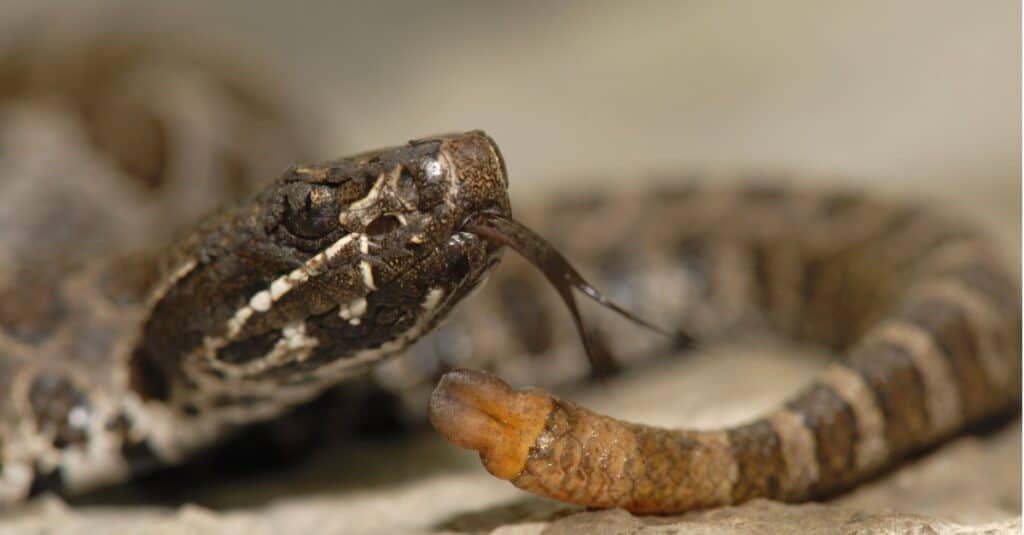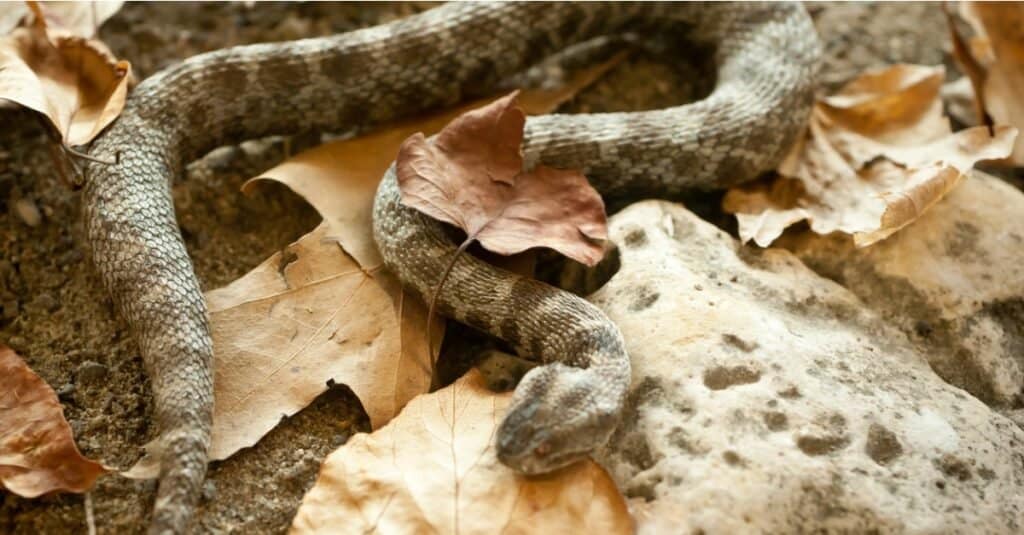Massasauga
.jumbotron {
background-image: url(“https://a-z-animals.com/media/2022/01/Massasauga-header-400×300.jpg”);
}
}
@media only screen and (min-width: 641px) and (max-width: 920px) {
.jumbotron {
background-image: url(“https://a-z-animals.com/media/2022/01/Massasauga-header-470×370.jpg”);
}
}
@media only screen and (min-width: 921px) {
.jumbotron {
background-image: url(“https://a-z-animals.com/media/2022/01/Massasauga-header.jpg”);
}
}
Massasauga
Sistrurus catenatus
The name “Massasauga” comes from the Chippewa language, meaning “Great River Mouth”.
Massasauga Scientific Classification
- Kingdom
- Animalia
- Phylum
- Chordata
- Class
- Reptilia
- Order
- Squamata
- Family
- Viperidae
- Genus
- Sistrurus
- Scientific Name
- Sistrurus catenatus
Read our Complete Guide to Classification of Animals.
Massasauga Conservation Status
Massasauga Facts
- Prey
- Small mammals, lizards, other snakes, centipedes
- Group Behavior
-
- Solitary
- Fun Fact
- The name “Massasauga” comes from the Chippewa language, meaning “Great River Mouth”.
- Litter Size
- 8-20 live young
- Habitat
- Prairie, marsh, and lake areas
- Diet
- Carnivore
- Common Name
- Massasauga Rattlesnake
- Location
- North America
This post may contain affiliate links to our partners like Chewy, Amazon, and others. Purchasing through these helps us further the A-Z Animals mission to educate about the world’s species..

Discover alligator-eating snakes, spiders larger than your phone, and 1000 more incredible animals in our daily FREE email.
.photo-gallery {
–margin: 0px auto 0px;
–padding: 0px 0px 0px 0px;
}
.gallery-link {
background-image: url(“https://a-z-animals.com/media/2022/01/Massasauga-hiding-in-leaves-1024×535.jpg”);
background-repeat: no-repeat;
background-size: cover;
background-position: center;
height: 500px;
justify-content: center;
text-align: center;
align-items: center;
display: flex;
border: 2px solid #000;
}
.gallery-link img {
height: 50%;
}
@media only screen and (max-width: 768px) {
.gallery-link {
height: 300px !important;
}
}
View all of the Massasauga images!
“Massasaugas produce young every one to three years, depending on access to food”
The Massasauga is often mistaken for the Fox Snakes, Hognose Snake, and Milk Snake. Markings that consist of black or brown splotches on these creatures are responsible for identification between the types of snakes being difficult. These rattlesnakes are not yet endangered but are facing habitat loss. Their location consists of prairie, marsh, and lake areas from northern Mexico, Texas, and Oklahoma to New York and southern Ontario.
Massasauga Amazing facts
- Often resides in other creatures’ burrows for shelter
- Rarely rattles and prefers staying still to avoid detection
- Males often fight to breed with a female
- The snake’s conservation status varies by area
Where To Find Massauga
Massasaugas have a wide range, with varying habitats. The animal’s name comes from a Chippewa word translated as “great river mouth,” with the pronunciation of mass-a-saw-ga. Distribution ranges from the Great Lakes regions of New York and southern Ontario, the Midwest including Illinois and Iowa, and extending as far west as Texas and Oklahoma, with an isolated population in Colorado. The very southernmost part of the reptile’s range is northern Mexico.
button.pulse {
transform: scale(1); animation: pulse 2s infinite;
box-shadow: 0 0 0 0 rgba(11, 247, 25, 1);
}
@keyframes pulse {
0% { transform: scale(0.90); box-shadow: 0 0 0 0 rgba(11, 247, 25, 0.5); }
60% { transform: scale(1); box-shadow: 0 0 0 15px rgba(11, 247, 25, 0); }
100% { transform: scale(0.90); box-shadow: 0 0 0 0 rgba(11, 247, 25, 0); }
}
Low-lying areas close to rivers and lakes are favorite spots for these snakes. Adjacent upland areas are preferred spots for the reptile to reproduce and bask. The Eastern Massasauga stays partially submerged during hibernation to allow easier breathing and prevent freezing.
Anyone who wants to find these snakes will need to look carefully because their colors make them blend in with their surroundings. These rattlesnakes are easiest to see during the warmer weather months, as with other snakes. Because these snakes are venomous, people should avoid getting bitten and observe these animals at a safe distance.
Types of Massasaugas
- Eastern Massasauga (Sistrus catenatus) – A primarily woodland and swamp or wetland-dwelling subspecies. Much of the habitat for these snakes has disappeared because of agricultural activity, particularly in the Great Lakes area. These snakes still present a bite risk if disturbed during outdoor activities.
- Western or Prairie Massasauga (Sistrurus catenatus tergeminus) – This reptile features lighter colors allowing it to blend into grassland settings more easily. Unlike their predominantly woodland and wetland-dwelling relatives, these snakes are more likely to inhabit burrows belonging to other animals.
Massasauga Scientific name
The Massasauga, often known as the Massasauga Rattlesnake, has a scientific name of Sistrurus catenatus or Sistrurus catenatus tergeminus, depending on whether it is the Eastern or Western variety. Both scientific names derive from Latin, and the species is part of the Viperidae family of pit vipers, predators who kill their prey with venom.
Massasauga Population & Conservation Status
Although the exact number of Massasaugas is unknown, there are 267 known historical populations of the Eastern Massasauga. The snake current has a Least Concern conservation status. However, continued habitat threats may result in the snakes being endangered, particularly the Eastern subspecies.
How To Identify the Massasauga: Appearance and Description
Massasauga identification involves familiarity with colors and markings that include tan, gray, or brown with dark brown or black splotches. Western Massasaugas usually have paler markings than their Eastern counterparts. The Eastern Massasauga is larger, measuring as much as 30 inches, while Western Massasaugas average 21 to 26 inches.
How to identify the Massasauga:
- Tan, gray or brown color
- Row of black or brown splotches down the back and along the sides
- Measures up to 30 inches long
Read about the largest massasauga ever recorded.
Massasauga Pictures

Rusty Dodson/Shutterstock.com

iStock.com/Shoemcfly

iStock.com/Westhoff
Massasauga Venom: How Dangerous Are They?
The Massasauga is highly poisonous, especially for its moderate size. In some circumstances, a bite can cause life-threatening or disabling health issues. The type of location that these snakes prefer minimizes the risk of human contact. However, prompt medical attention is necessary if you get bitten.
Massasauga Behavior and Humans
Although the Massasauga is venomous, its chances of interacting with humans are low. The pronunciation of the species’ name, basic facts, and identification frequently elude people unaccustomed to encountering this species. Although they have a dangerous bite, these snakes are not usually aggressive unless unable to escape a threat.
View all 114 animals that start with M
Massasauga FAQs (Frequently Asked Questions)
Are Massasauga venomous?
Yes, Massasaugas are poisonous, using venom to kill their prey, including small rodents like mice.
How do Massasaugas hunt?
Massasaugas have markings allowing them to blend in with their surroundings, largely remaining invisible to their prey.
Are Massasaugas aggressive?
Massasaugas usually avoid conflict with potential predators but will defend themselves if threatened.
Where do Massasaugas live?
Massasaugas usually inhabit wetland areas, woods, and prairies, with river mouth areas where many of them live, contributing to their name with the pronunciation mass-a-saw-ga.
What do Massasaugas eat?
The Massasauga’s diet consists of mice and other small rodents, lizards, and some smaller snakes.
Why is the Massasauga rattlesnake endangered?
Although this snake has not reached an endangered status, the loss of natural habitats that affect its diet, reproduction, and lifespan have made it a threatened species in some states, such as Michigan.
Is the Massasauga snake poisonous?
The Massasauga is venomous, with one of the top facts being that the reptile uses venom to hunt and as protection against predators.
What do you do if you get bitten by a Massasauga Rattlesnake?
If a Massasauga bites you, seek medical attention because their bites are damaging regardless of the individual snake’s size.
Where do Massasauga snakes live?
Massasaugas prefer a woodland, marshy, or prairie location, with a range extending from southern Canada to northern Mexico.
How many Massasauga rattlesnakes are left in the world?
The precise size of the Massasauga population is challenging to know, with the varying lifespan and population ranges. Still, there are nearly 300 historical populations at a minimum in the United States.
Sources
- Britannica, Available here: https://www.britannica.com/animal/massasauga
















